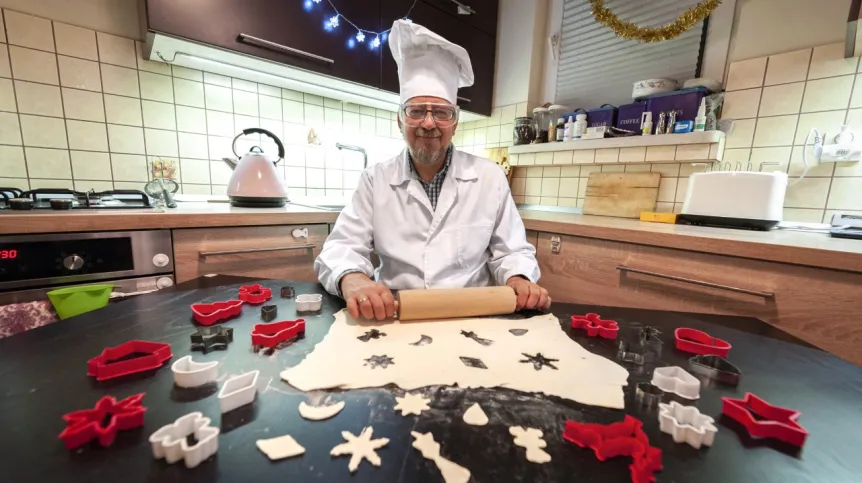
Polish scientists worked on the novel chemosensor to measure many more parameters from a single droplet of biological fluids.
We live in times when technology has become a regular part of our lives. Besides many portable devices, smartphones or wrist-worn fitness trackers are equipped with sensors to measure health parameters like pulse or blood saturation with oxygen. The appearance of such devices on the market made our lives easier. It revolutionized medicine, enabling us to check even the glucose level at home.
Recently, scientists from the Institute of Physical Chemistry, Polish Academy of Sciences, Łukasiewicz Research Network - Pharmaceutical Research Institute Warsaw (currently - the Industrial Chemistry Institute), Warsaw Medical University, and Cardinal Stefan Wyszynski University led by dr. Krzysztof Noworyta worked on the novel chemosensor to measure many more parameters from a single droplet of biological fluids. Researchers made a unique and highly advanced platform to sense particular chemical compounds just within a few seconds. Let us take a closer look at their discovery.
Accurate predicting the course of some diseases in a personalized way is one of the significant challenges in medicine. Researchers work on miniaturized, portable platforms making fast, real-time analysis a solution towards monitoring the different drug levels in biological fluids. One of them is Cilostazol, the drug used to decrease the muscles' pain, increase blood flow, and the oxygen level at the muscles. This drug is mainly used to treat peripheral vascular disease and intermittent claudication. At the same time, it can also be used against Alzheimer's disease and diabetes treatment. Its level in the biological fluids is significant for effective treatment and reduction of the side effects. Among different types of assays used in clinical laboratories to determine concentrations of various drugs in biological fluids for therapeutic drug monitoring, researchers attempt to construct devices making it possible to make a drug level analysis without visiting diagnostics facilities.
Recently, researchers from the Institute of Physical Chemistry, Polish Academy of Sciences (IPC PAS) led by dr. Krzysztof Noworyta, under collaboration with the Lukasiewicz Research Network - Pharmaceutical Research Institute Warsaw (currently - the Industrial Chemistry Institute), Warsaw Medical University, and Cardinal Stefan Wyszynski University, designed a fast and efficient way of determination of Cilostazol's concentration in various solutions. Scientists prepared the electrode and coated it with the polymer that is molecularly imprinted. How does it work? They have incorporated a proposed drug in a polymer matrix at its formation stage. After removing this "template" and forming a complex structure, the polymer was selective towards this particular drug. It works like a three-dimensional shape puzzle toy where only the object with a specific shape fits in a slot. In this example, the Cilostazol would be a molecule, and the toy is a selective polymer matrix. Each molecule has a particular shape and size, so molecules different from Cilostazol would not fit in such a complex structure.
"The presented results could not be archived without the close collaboration of researchers with different backgrounds related to synthetic chemistry, quantum modeling, and pharmaceutical analysis. And of course, without hard work and ideas of M.Sc. Jyoti, a Ph.D. student in our Institute, who was heavily involved in this project." - remarks Dr. Noworyta.
It seems to be easy, while the design of the chemosensor selective to this drug and effective monitoring of its concentration in the biological fluids is a different story. To do so, researchers synthesized the polymer matrix directly onto the electrode for the following electrochemical signal detection. All thanks to the imprinted polymer layer onto the electrode, forming a stable chemical structure with Cilostazol. After the deposition onto the conducting surface, the binding reaction can be measured electrochemically. The polymer is efficiently conducting electricity. In the presence of the Cilostazol in its structure, the electric charge transfer in the matrix is disturbed. That way, the chemical signal can be easily processed and presented with an electrochemical one, especially when miniaturized and possibly combined with lab-on-chip diagnostic solutions. Additionally, based on the proposed material, it is possible to create versatile platforms that enable the miniaturization of laboratory functions.
Dr. Noworyta claims: "We have demonstrated that the chemosensors fabricated may help with optimizing drug dosage and diagnostics within the Cilostazol and its metabolites concentration ranges in body fluids. Our future research will aim to make the chemosensor reusable and cross-validate its performance with other techniques".
Moreover, complementary to the experiments, scientists performed quantum-mechanical calculations determining the interactions between the particular imprinted molecules in the cavities of the prepared matrix. Thanks to these analyses, they could estimate the molecular affinity of Cilostazol to the matrix and find out the types of interactions responsible for binding. This allowed better designing the imprinted polymer.
The monitoring of the therapeutic drug's concentration can be used during treatment and for diagnostic purposes. Commonly, the cilostazol concentration at the place of action cannot be routinely measured; however, the desired or adverse effects may correlate better with its concentration in biological fluids than they do with dose. It can be changed with the solution proposed by researchers from IPC PAS. Thanks to its monitoring assays within the proposed way, we are a step closer to performing real-time analysis of the sudden drop of such drug levels in biological fluids and controlling the drug's dose depending on the particular parameters, including individual health parameters. This research was published on 2nd August 2021 in Biosensors and Bioelectronics.
Source: IPC PAS
kap/













